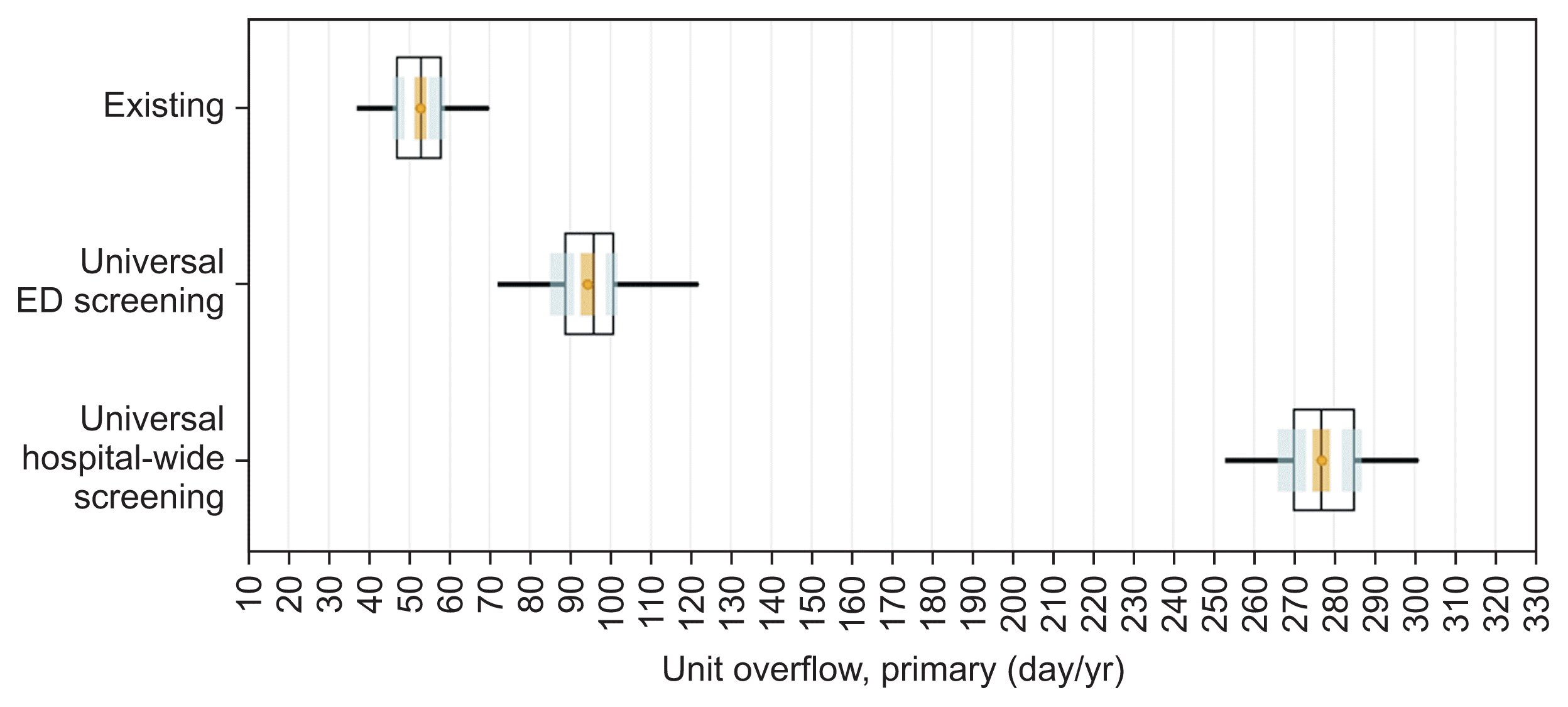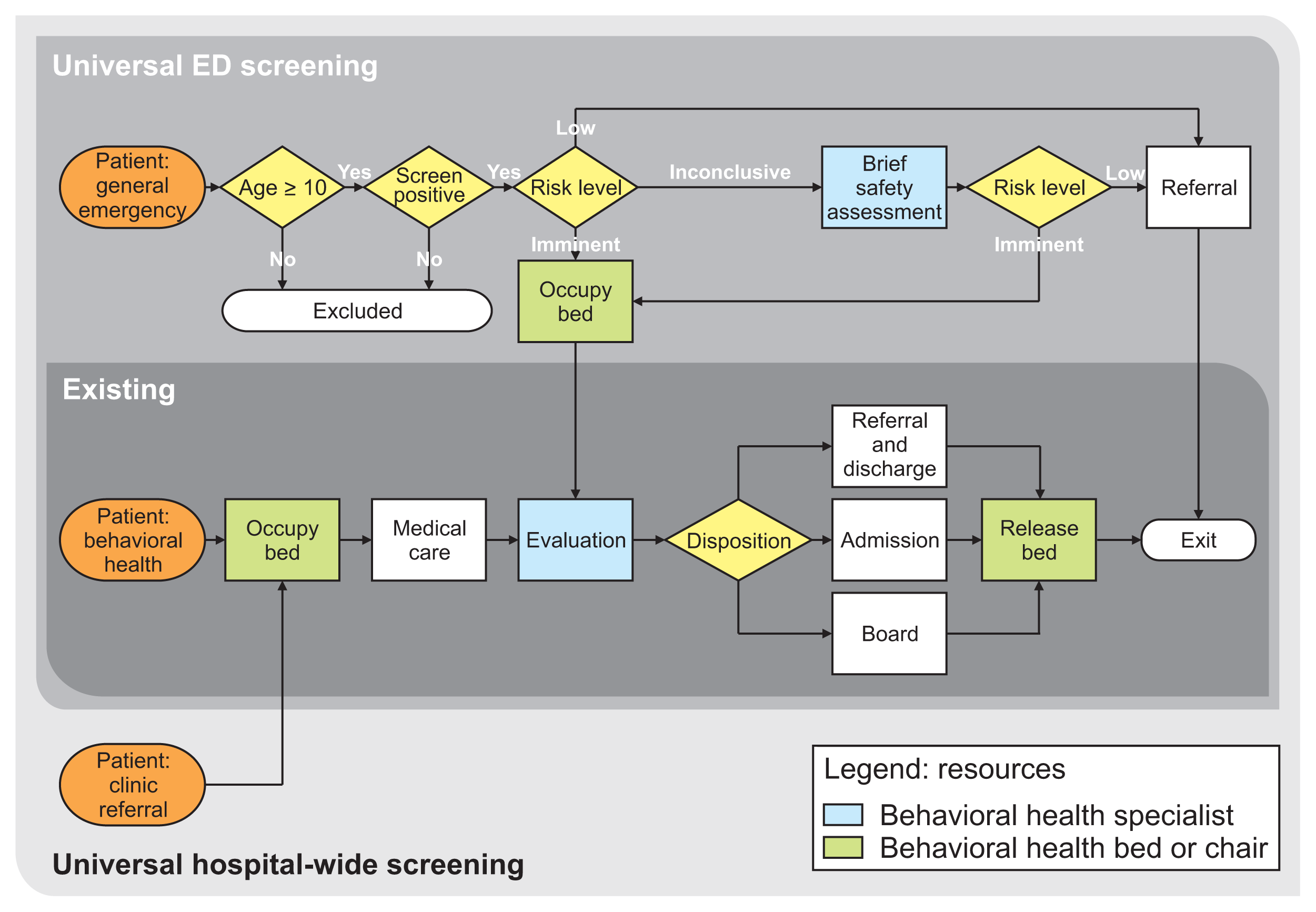I. Introduction
1. Background
2. Importance
3. Goals of This Investigation
II. Methods
1. Discrete Event Simulation Modeling
2. Study Setting
3. Conceptual Modeling
1) Universal ED screening
2) Universal hospital-wide screening
4. Data Collection and Model Parameters
5. DES Model Building and Validation
6. Model Experiments and Outcome Measures
Figure 2

7. Sensitivity Analyses
III. Results
1. Model Parameters
Table 1
| Process | Data source | Parameter | Service time distributionc (min) |
|---|---|---|---|
| Patients evaluated by psychiatry team | |||
| Arrival ratea | Derivation dataset (n = 1,058) | Poisson (λ) | - |
| Admission rate | Derivation dataset (n = 448 of 1,058) | Fixed 42.3% chance | - |
| Boarding rateb | Derivation dataset (n = 85 of 1,058) | Fixed 0.08% chance | - |
| Medical care for patients with behavioral health complaints | Derivation dataset (n = 1,049) | - | 9 + Weibull (155, 1.21) |
| Complete behavioral health evaluation | Derivation dataset (n = 1,017) | - | 39 + Weibull (99.3, 1.08) |
| Wait time for inpatient bed, admitted patients | Derivation dataset (n = 397) | - | 9 + Weibull (527, 0.77) |
| Boarding time for emergency department (ED) boarders | Derivation dataset (n = 56) | - | 137 + Weibull (1220, 1.27) |
| Nurse discharge process | Expert opinion | Triangular (5, 10, 15) | |
a Variable arrival rate with distinct λ each hour, ranging from 0.001 to 1.089 patients per hour depending on month, day of week, and hour of day.
b Boarding rate includes only patients who board in the ED prior to discharge home. Patients that board in the ED prior to admission are included in admission rate.
The Weibull distribution has a closed-form inverse cumulative distribution function given by: F-1(U) = b [−ln(1-U)]1/a
2. Model Verification and Validation
Table 2
3. Model Experimentation Outcomes
Figure 3

Table 3
4. Sensitivity Analyses
Table 4
| Metrics for BHC patients | Model output | ||
|---|---|---|---|
| Existing system | Universal ED screeninga | Universal hospital-wide screeninga | |
| Wait time (hr) | 2.91 ± 0.01 | 3.08 ± 0.01 | 3.49 ± 0.03 |
| Length of stay (hr) | |||
| Overall | 11.28 ± 0.05 | 11.39 ± 0.05 | 11.85 ± 0.06 |
| Admitted patients | 15.58 ± 0.09 | 15.64 ± 0.09 | 16.16 ± 0.08 |
| Boarded patients | 26.38 ± 0.24 | 26.54 ± 0.24 | 26.95 ± 0.24 |
| Discharged patients | 5.17 ± 0.02 | 5.33 ± 0.02 | 5.75 ± 0.03 |
| Unit overflow (day/yr) | 52.90 ± 1.43 | 93.50 ± 1.60 | 266.00 ± 2.02 |
a Social worker performs brief safety assessment. In our initial testing of proposed system changes, we programmed our model to have brief safety assessments performed by psychiatry social workers, responsible for all other behavioral health complaint management in the emergency department. Subsequent pre-implementation planning has proposed the use of emergency department social workers for these brief safety assessments to make sure psychiatry social workers remain available for complete behavioral health evaluations.




 PDF
PDF Citation
Citation Print
Print




 XML Download
XML Download